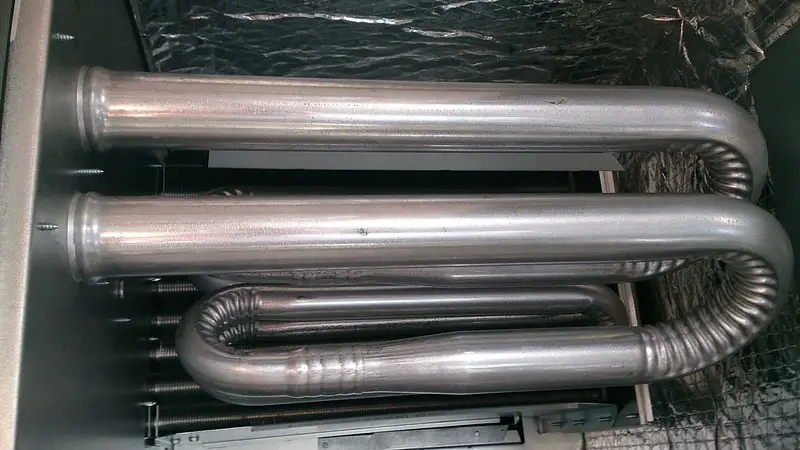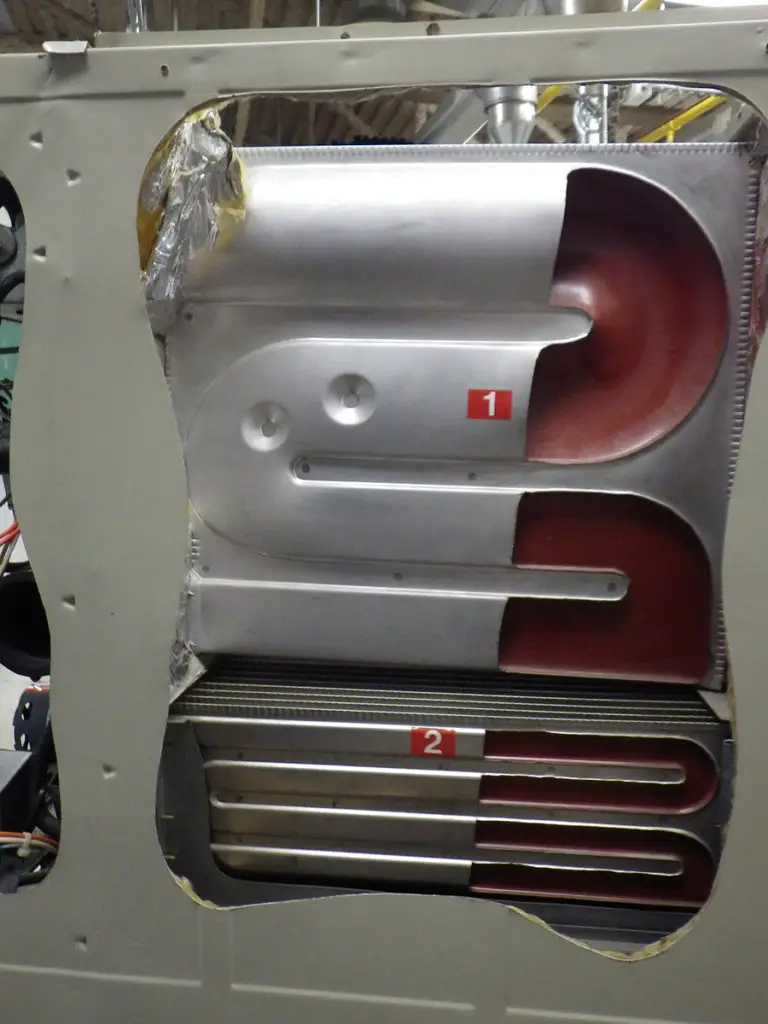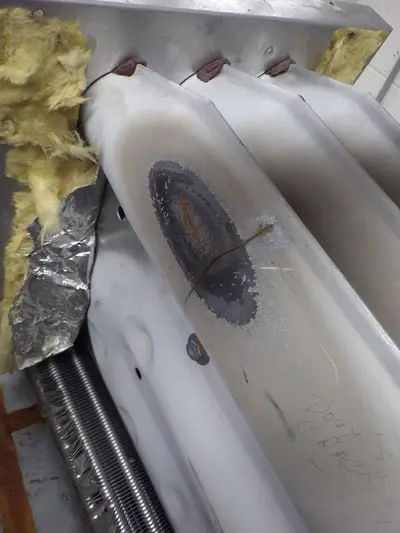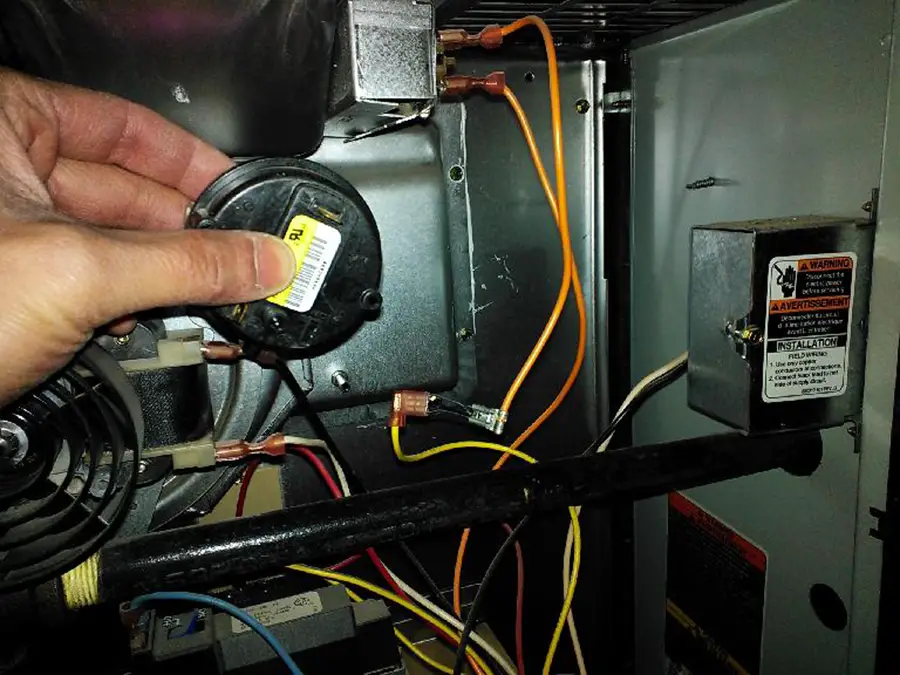Image Source
We all want our home and its components to last as long as possible. Inevitably, the equipment in our home will fail or break and need to be replaced. When it comes to heaters that use combustion to work, a damaged furnace could be dangerous. Knowing about heat exchangers, the role they play, and the signs that your heat exchanger is cracked will not only keep you and your family safe, but allow you to speak to an HVAC professional more intelligently and ask the right questions.
- What does a heat exchanger do?
- Where is your heat exchanger located?
- What does a heat exchanger look like?
- What are the symptoms of a cracked heat exchanger?
- Is a heat exchanger crack dangerous?
- What causes cracks?
- Can I prevent a heat exchanger crack?
- My heat exchanger is cracked. Now what?
- How much will it cost to replace?
What does a heat exchanger do?
If you have a gas-fed furnace in your home, then at the heart of it, you will find a heat exchanger. The burners ignite the fuel source which creates heat and gasses. The heat and gasses will then get pulled through the heat exchanger on their way to the exhaust. The exhaust is where the gasses will be pushed out of your home through a vent pipe penetrating an exterior wall or roof. The heat exchanger is heated up as the gasses pass through it, which will then trigger your blower fan to run. The blower fan pushes air across the heat exchanger which warms the air and is then distributed throughout your home.
Where is your heat exchanger located?
If you have a gas furnace and have ever seen the burner assembly (which is the portion in charge of burning the fuel source) then the holes that the flames are sucked through will be the lowest part of the heat exchanger. From there, it will take up most of the furnace from front to back, and all the way up to either the top of the furnace, or in the case of package units, as high as the exhaust vent.
What does a heat exchanger look like?

There are several styles of heat exchangers, but we will discuss the two most common. The first type looks like a piece of pipe that someone has been bent into a repeating “S” shape or some kind of variant of an “S.” This “S” will be made of a round pipe that goes back and forth until it terminates behind the exhaust fan.
The other common type will look more like two pieces of flat steel that have been pressed together. It is a similar concept to the first with channels running in between the two sheets of metal, in similar “S” shapes. However, this is done with two sheets of steel, instead of pipe. These were quite common on older furnaces that used a natural draft venting system over the current forced-air venting system that we see today.

What are the symptoms of a cracked heat exchanger?
The cracking of a heat exchanger is exactly that, a crack that has formed in either the pipe or pressed metal enclosure. Your heat exchanger may have developed enough rust, causing a hole to form, or it could mean that your furnace has a more serious problem that has caused the heat exchanger to fail prematurely by causing the steel tubing to crack from overheating.
There are a few common symptoms to look for if you think your heat exchanger is cracked:
- “Dancing” flames
- Excessive soot at the exhaust, burner assembly, or on the heat exchanger
- Symptoms of carbon monoxide poisoning like headaches, upset stomach, dizziness, confusion, or weakness
- Your carbon monoxide detector going off
- Unique or new sounds or smells
The most obvious sign of a cracked heat exchanger will be that the burner flames are “dancing” around and have a more yellow appearance. However, this could also mean that there is a restriction in the system which is not allowing the exhaust to be pushed out of the home properly.
The next thing to look for is excessive soot. Your furnace will have an exhaust vent that penetrates the exterior of your home. Depending on the efficiency of your furnace this may be a metal pipe or PVC piping. If your exhaust vent is somewhere visible or easily accessible, you can inspect it to see if it is covered or filled with an excessive amount of black soot. If you can access the burner assembly and visible portions of your heat exchanger easily, you can also inspect those areas for excessive soot.
Finally, if you or your family members begin not feeling well but feel better once you leave your home, you need to turn your furnace off and call a professional immediately. The heat exchanger is where the combustion gasses travel, so if you have a crack, they may be able to escape and gain access to your home. You may not be able to smell these gasses, so abnormal headaches or nausea could be signs of a problem and should be addressed immediately. You should always maintain a quality functioning carbon monoxide tester in your home.

Is a heat exchanger crack dangerous?
Yes, any crack in your heat exchanger is considered hazardous to your health and should be assessed by an HVAC professional as soon as possible. Once a crack develops it can potentially let gasses into your home, which can be deadly if you are exposed to a large enough volume, or for a long enough span of time. Your furnace will need to be shut down until a solution to the problem is decided upon. Having a functioning carbon monoxide detector is an important part of keeping you and your family safe.
What causes cracks?
The most common causes of a heat exchanger becoming cracked are age, improper installation, or poor airflow. Heat exchangers are traditionally made from steel, and therefore will rust which leads to cracks. A lot of HVAC manufacturers are now using stainless steel for their heat exchangers and offering lifetime warranties. Stainless steel takes much longer to develop rust and will outlive the lifespan of the furnace if installed properly.
Improper airflow is another reason that your heat exchanger may fail. Your furnace must have air moving across the heat exchanger to prevent it from overheating. Things like dirty filters or a dirty coil that will not allow the air to move freely across the heat exchanger will cause the furnace to run at higher temperatures than it was intended. This can cause the heat exchanger to heat above its intended temperature which will lead to a malfunction.
It’s possible that the installation company that installed the unit in your home may have installed one that is too large, or installed ductwork too small for the furnace to efficiently disperse the heat. The issue with having too large of a unit installed is that it will heat your home up to quickly and shut off. This will cause the furnace to cycle from hot to cold much more often than it is supposed to. The constant heat and cooling of the metal heat exchanger will cause it to warp or crack.
Can I prevent a heat exchanger crack?
Ensuring that your furnace will run efficiently and for its intended lifespan starts with having that unit installed by a trusted HVAC professional. Making sure that the installation company is installing the correct size unit will be the first step to making sure your heat exchanger lasts for the long haul. Don’t be afraid to ask your installation company questions about your unit and duct sizing. It is better for you to understand what is happening now, so you are not left out in the cold later.
Another way that you can prevent a crack is by doing proper maintenance on your furnace. Changing your filter regularly before it gets completely clogged will not only help your heater but your air conditioner as well. A clean filter will help maintain proper airflow, keeping your furnace at the correct operating temperature. Having an HVAC company inspect your HVAC system twice a year every year to ensure that it is working properly will help your furnace to continue heating for years to come.
Related: HVAC Air Filters: Which One Should You Choose
My heat exchanger is cracked. Now what?
The problem with being told that your heat exchanger has a crack is that your furnace is likely still working fine. Some homeowners seem to think that the service tech is wrong, or just trying to charge them more for the call. This is a point where you will have to trust your service tech because the truth is that a crack is dangerous and can be deadly if left untreated.
When a crack is found the heat exchanger, or the entire furnace, will have to be replaced. Unfortunately, fixing the heat exchanger is not an option and it must be replaced to continue safe operation.
Depending on the age of your furnace you may be able to claim it under warranty. However, there are specific rules and timelines that you will have to meet before this will apply to your furnace. Your preferred HVAC company will be able to help you figure out whether or not it is under warranty.
How much will it cost to replace?
From my experience, a new heat exchanger is roughly half the cost of a new furnace, although this can vary greatly between brands and styles of furnaces. However, you will have to also pay an HVAC service company to install the heat exchanger. On top of the price of the part, you will have multiple billed hours for the installation due to them having to disassemble most of the unit to get it replaced. This is commonly done on package units, where the entire system sits outside in one unit that is combined with the air conditioning system. In this case, changing a heat exchanger is cheaper than replacing the entire unit. This may not be the case for smaller, easier to replace furnaces more likely to be found in your home. Replacing the entire furnace tends to be more popular on split systems where the furnace sits by itself. In this case, a heat exchanger installed is not much cheaper than buying a new furnace, which means the entire unit will be new and come with a warranty. It’s especially beneficial to replace the furnace if you have an older model that is not as efficient, like an 80% furnace. You may be able to upgrade to a 90% or 95% model at the time of replacement, which will use much less fuel.
How much these options will cost will depend on what part of the country you live in, which brand of furnace you have, or which unit you are having installed. Having to pay for a heat exchanger replacement out of pocket will run you between $1000-$2000 while having a new furnace installed will run $2000-$7000. These prices may vary widely depending on the size of unit, the efficiency rating, and the brand. The top tier and most well-known brands such as Carrier and Trane will demand a higher price than the lower lesser-known companies such as Heil or Payne.
What’s your experience with damaged heat exchangers? Let us know in the comments below.




